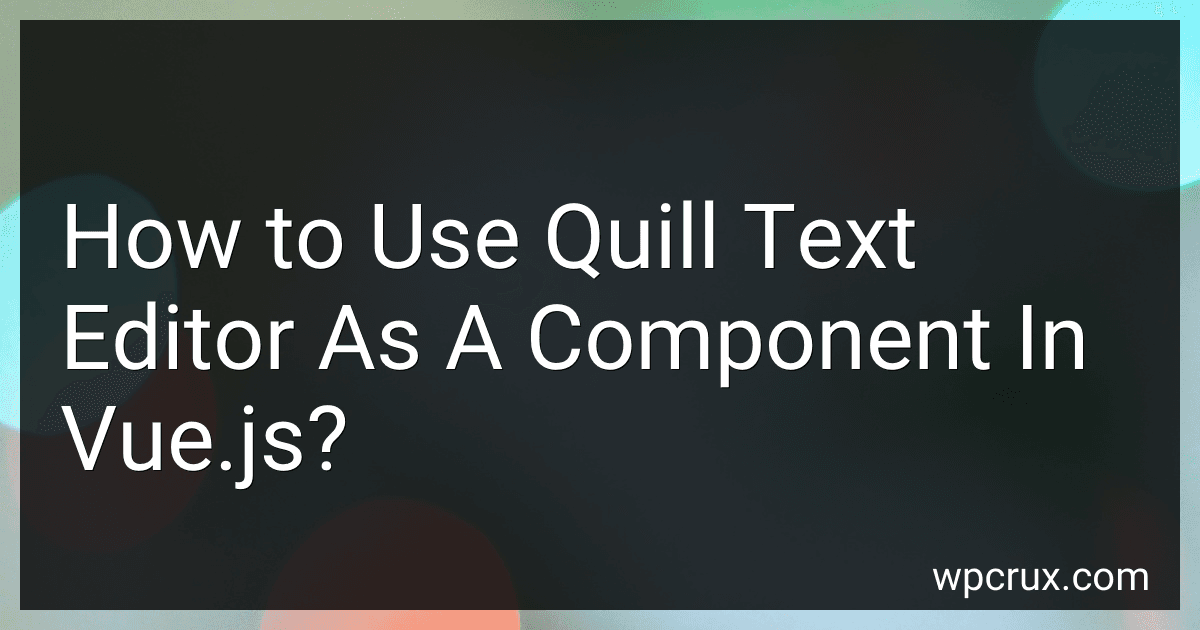Best Vue.js Text Editor Components to Buy in October 2025

Dear Editor


Quill is a powerful rich text editor that can be easily integrated as a component in Vue.js applications. To use Quill text editor as a component in Vue.js, you need to install the Quill package, either through npm or by adding the CDN link to your HTML file.
Next, you can create a new Vue component for Quill editor and import Quill into your component. You can then initialize Quill in the mounted() lifecycle hook of your component and set up any custom options or configurations you need.
You can then bind the Quill editor to a textarea element in your template using v-model or by setting up a two-way data binding. This allows you to access and manipulate the content of the editor within your Vue component.
Overall, integrating Quill text editor as a component in Vue.js is a straightforward process that can enhance the user experience of your application by providing a powerful and customizable rich text editing tool.
How to enable/disable Quill editor in Vue.js?
To enable or disable the Quill editor in Vue.js, you can use a boolean variable to toggle the editor's availability. Here's an example of how you can achieve this:
- First, install the Quill editor package using npm or yarn:
npm install vue-quill-editor
- In your Vue component, import the Quill editor:
import { quillEditor } from 'vue-quill-editor'
- Define a data property to control the availability of the editor:
data() { return { isEditorEnabled: true } }
- In your template, conditionally render the Quill editor based on the isEditorEnabled variable:
- Define a method to toggle the isEditorEnabled variable:
methods: { toggleEditor() { this.isEditorEnabled = !this.isEditorEnabled } }
Now, when you click the "Toggle Editor" button, the Quill editor will be enabled or disabled based on the value of the isEditorEnabled variable.
How to initialize Quill editor in Vue.js?
To initialize Quill editor in Vue.js, you can follow these steps:
- Install Quill via npm:
npm install quill
- Import Quill in your Vue component:
import Quill from 'quill';
- Add a textarea element in your template where you want the Quill editor to be displayed:
- In the mounted hook of your Vue component, initialize the Quill editor:
mounted() { this.quill = new Quill(this.$refs.editor, { theme: 'snow', // or 'bubble' for a different theme modules: { toolbar: [ ['bold', 'italic', 'underline', 'strike'], ['link', 'image'], ['clean'] ] } }); }
- You can also bind the Quill editor's content to a data property in your component for two-way data binding:
data() { return { editorContent: '' } },
- You can then update the editorContent whenever the editor's content changes:
this.quill.on('text-change', () => { this.editorContent = this.quill.root.innerHTML; });
- To set the initial content of the editor, you can use the setContents method:
this.quill.setContents([{ insert: this.editorContent }]);
That's it! You have now initialized the Quill editor in your Vue.js component. Keep in mind that you may need to further customize the Quill editor based on your specific requirements.
How to install Quill text editor in Vue.js?
To install Quill text editor in Vue.js, you can follow these steps:
- Install Quill using npm:
npm install quill
- Import Quill in your Vue component:
import Quill from 'quill';
- Create a Quill instance in your Vue component:
mounted() { this.quill = new Quill('#editor', { theme: 'snow', modules: { toolbar: [ [{ 'header': '1'}, {'header': '2'}, {'font': [] }], [{'list': 'ordered'}, {'list': 'bullet'}, {'indent': '-1'}, {'indent': '+1'}], ['bold', 'italic', 'underline'], ['link', 'image', 'video'], ['clean'] ] } }); }
- Add the HTML element to your Vue template where you want the Quill editor to be displayed:
- To get the contents of the editor, use this.quill.root.innerHTML in your Vue component.
That's it! You have successfully installed Quill text editor in your Vue.js application.
How to implement syntax highlighting in Quill editor in Vue.js?
To implement syntax highlighting in Quill editor in Vue.js, you can use a library called Quill Better Table which provides syntax highlighting features for Quill editor.
Here is the step-by-step guide on how to implement syntax highlighting in Quill editor in Vue.js:
- First, install Quill and Quill Better Table libraries using npm:
npm install quill quill-better-table
- Create a new Vue component for the Quill editor:
- Add syntax highlighting features to the Quill editor by using the Quill Better Table module:
// Initialize Quill editor const quill = new Quill(this.$refs.editor, { modules: { table: true, 'better-table': { syntaxHighlight: true } }, theme: 'snow' })
- Now you should have a Quill editor with syntax highlighting features implemented in your Vue.js application.
Note: Make sure to customize the Quill editor's configuration and styling according to your needs.
How to create custom themes for Quill editor in Vue.js?
To create custom themes for Quill editor in Vue.js, you can follow these steps:
- Install Quill editor: Install Quill editor in your Vue.js project by running the following command in your terminal:
npm install quill
- Create a custom theme: Create a new file in your project (e.g., CustomTheme.js) and define your custom theme using the Quill editor API. Here is an example of a custom theme that changes the background color of the editor:
// CustomTheme.js
import Quill from 'quill';
const CustomTheme = Quill.import('core/theme');
class MyCustomTheme extends CustomTheme { constructor(quill, options) { super(quill, options);
this.quill.root.style.backgroundColor = '#f0f0f0'; // Set the background color
} }
Quill.register('themes/myCustomTheme', MyCustomTheme);
export default MyCustomTheme;
- Register the custom theme: Import the custom theme in your Vue component where you are using the Quill editor and register it with the Quill editor instance. Here is an example of how you can register the custom theme in a Vue component:
// MyQuillEditor.vue
- Use the custom theme: Now you can use the custom theme in your Quill editor by specifying the theme name when initializing the editor instance.
By following these steps, you can create and use custom themes for Quill editor in Vue.js. You can customize the appearance and behavior of the editor by defining your own custom themes.
